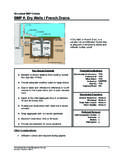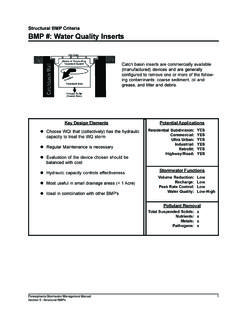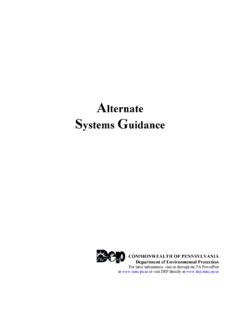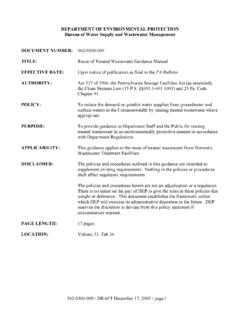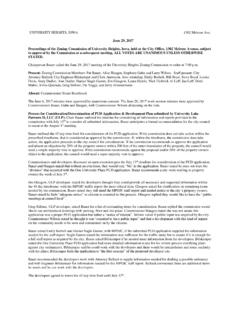Transcription of BMP #: Constructed Wetlands
1 Structural BMP Criteria BMP #: Constructed Wetlands Constructed Wetlands are shallow marsh sys- tems planted with emergent vegetation that are designed to treat stormwater runoff. Fish and Wildlife Service, 2001. Key Design Elements Potential Applications z Adequate drainage area (usually 5 to 10 acres Residential Subdivision: YES. Commercial: YES. minimum). Ultra Urban: LIMITED. Industrial: YES. z Maintenance of permanent water surface Retrofit: YES. Highway/Road: YES. z Multiple vegetative growth zones through vary- ing depths stormwater Functions z Robust and diverse vegetation Volume Reduction: Low z Relatively impermeable soils or engineered liner Recharge: Low Peak Rate Control: High Water Quality: High z Sediment collection and removal z Adjustable permanent pool and dewatering Pollutant Removal mechanism Total Suspended Solids: x Nutrients: x Metals: x Pathogens: x Pennsylvania stormwater Management Manual 1. Section 5 - Structural BMPs Figure 1.
2 Demonstration Constructed Wetlands in Arizona ( ). Description Constructed Wetlands are shallow marsh systems planted with emergent vegetation that are designed to treat stormwater runoff. While they are one of the best BMPs for pollutant removal, Constructed Wetlands (CWs) can also mitigate peak rates and even reduce runoff volume to a certain degree. They also can provide considerable aesthetic and wildlife benefits. CWs use a relatively large amount of space and require an adequate source of inflow to maintain the perma- nent water surface. Variations Constructed Wetlands can be designed as either an online or offline facilities. They can also be used effectively in series with other flow/sediment reducing BMPs that reduce the sediment load and equalize incoming flows to the CW. Constructed Wetlands are a good option for retrofitting existing detention basins. CWs are often organized into four groups: z Shallow Wetlands are large surface area CWs that primarily accomplish water quality improvement through displacement of the permanent pool.
3 Z Extended Detention Shallow Wetlands are similar to Shallow Wetlands but use extended detention as another mechanism for water quality and peak rate control. z Pocket Wetlands are smaller CWs that serve drainage areas between approximately 5 and 10 acres and are Constructed near the water table. z Pond/ wetland systems are a combination of a wet pond and a Constructed wetland . Although this BMP focuses on surface flow Constructed Wetlands as described above, subsurface flow CWs can also be used to treat stormwater runoff. While typically used for wastewater treat- ment, subsurface flow CWs for stormwater may offer some advantages over surface flow wet- lands, such as improved reduction of total suspended solids and oxygen demand. They also can reduce the risk of vectors (especially mosquitoes) and safety risks associated with open water. However, nitrogen removal may be deficient (Campbell and Ogden, 1999). Perhaps the biggest disadvantage is the relatively low treatment capacities of subsurface flow CWs they are gener- ally only able to treat small flows.
4 For more information, please consult the References and Additional Resources list. 2 Pennsylvania stormwater Management Manual Section 5 - Structural BMPs Applications z Alternating bands of deeper water and shallow marsh. Figure 2. Banded Bathymetric Constructed wetland (Auckland pp 6-10). z Wet Pond/ wetland System Figure 3. Pond/ wetland System (Maryland pp ). Pennsylvania stormwater Management Manual 3. Section 5 - Structural BMPs z Pocket wetland Figure 4. Pocket wetland (Georgia Vol. 2, Section 20-3-2-2). 4 Pennsylvania stormwater Management Manual Section 5 - Structural BMPs z Offline Constructed wetland z Retrofit for existing detention basins Figure 5. Constructed wetland Created from an Existing Detention Basin (Tredyffrin Twp., PA). Design Considerations 1. HYDROLOGY. Constructed Wetlands must be able to receive and retain enough flow from rain, runoff, and groundwater to ensure long-term viability. Hydrologic calculations (or a water balance) should be performed to verify this.
5 Shallow marsh areas can become dry at the surface but not for greater than one month, even in the most severe drought. A permanent water surface in the deeper areas of the CW should be maintained during all but the driest periods. A relatively stable normal water surface elevation will reduce the stress on wetland vegetation. A CW must have a drainage area of at least 10 acres (5 acres for pocket Wetlands ) or some means of sus- taining constant inflow. Even with a large drainage area, a constant source of inflow can improve the biological health and effectiveness of a Constructed wetland . Pennsylvania's precipitation is generally well distributed throughout the year and is therefore suited for CWs. Example of stabilized inflow channel during construction. Pennsylvania stormwater Management Manual 5. Section 5 - Structural BMPs 2. UNDERLYING SOILS. Underlying soils must be identified and tested. Generally hydrologic soil groups C and D are suitable without modification, A and B soils may require a clay or synthetic liner.
6 Soil permeability must be tested in the proposed Constructed wetland location to ensure that excessive infiltration will not cause the CW to dry out. If necessary, CWs should have a highly- compacted subsoil or an impermeable liner to minimize infiltration. 3. PLANTING SOIL. Organic soils should be used for Constructed Wetlands . Organic soils can serve as a sink for pollutants and generally have high water holding capacities. They will also facilitate plant growth and propagation and may hinder invasion of undesirable species. 4. SIZE AND VOLUME. The area required for a CW is generally 3 to 5 percent of its drainage area. CWs should be sized to treat the water quality volume and, if necessary, to mitigate the peak rates for larger events. 5. VEGETATION. Vegetation is an integral part of a wetland system. Vegetation may help to reduce flow velocities, promote settling, provide growth surfaces for beneficial microbes, uptake pollutants, prevent resuspension, provide filtering, limit erosion, prevent short-circuiting, and maintain healthy bottom sediments (Braskerud, 2001).
7 Constructed Wetlands should have several different zones of vegetation as described in Table 5-X. The emergent vegetation zone (areas not more than 18 deep) should comprise about 60 to 65 percent of the normal water surface area, although recommendations in recent literature range from less than 50 to over 80 percent. Table 5-X. Vegetation Zone Description Open Water Areas between 18 inches and 6 feet deep Emergent Vegetation Areas up to 18 inches deep, contains the majority of aquatic vegetation Low Marsh Portion of Emergent Vegetation Zone between 6 and 18 inches deep High Marsh Portion of Emergent Vegetation Zone up to 6 inches deep Ephemeral Storage Area that is periodically inundated during runoff events Buffer Area outside of maximum water surface area Example of recently planted Constructed wetland . 6 Pennsylvania stormwater Management Manual Section 5 - Structural BMPs Robust, non-invasive, perennial plants that establish quickly are ideal for CWs.
8 The designer should select species that are tolerant of a range of depths, inundation periods, etc. Monoculture planting must be avoided due to the risk from pests and disease. See Appendix X for recom- mended plant lists. 6. CONFIGURATION. a. General. Constructed Wetlands should be designed with a length to width ratio of at least 2:1 wherever possible. If the length to width ratio is lower, the flow pathway through the CW should be maximized. CWs should not be Constructed within 10 feet of the property line or within 50 feet of a private well or septic system. CWs should be designed so that the 10-year water surface elevation does not exceed the normal water surface elevation by more than 3 feet. Slopes in and around Constructed Wetlands should be 4:1 to 5:1. (horizontal:vertical) whenever possible. b. Forebay/Inflows. Constructed Wetlands should have a forebay at all major inflow points to capture coarse sediment, prevent excessive sediment accumulation in the remainder of the CW, and minimize erosion by inflow.
9 The forebays should contain 10 to 15 percent of the total permanent pool volume and should be 4 to 6 feet deep (at least as deep as other open water areas). They should be physically separated from the rest of the wetland by a berm, gabion wall, etc. Flows exiting the forebay must be non-erosive to the newly con- structed CW. Vegetation within forebays can increase sedimentation and reduce resuspension/erosion. The forebay bottom can be hardened to facilitate sediment removal. Forebays should be installed with permanent vertical markers that indicate sediment depth. Inflow channels should be fully stabilized. Inflow pipes can discharge to the surface or be partially submerged. CWs must be protected from the erosive force of the inflow. c. Vegetation and Open Water Zones. About half of the emergent vegetation zone should be high marsh (up to 6 deep) and half should be low marsh (6 to 18 deep). Varying depths throughout the CW can improve plant diversity and health.
10 The open water zone (approx. 35 to 40% of the total surface area) should be between 18 inches and 6 feet deep. Allow- ing a limited 5-foot deep area can prevent short-circuiting by encouraging mixing, enhance aeration of water, prevent resuspension, minimize thermal impacts, and limit mosquito growth. Alternating areas of emergent vegetation zone (up to 18 inches deep) and open water zone as shown in Figures 2 and 4 can also minimize short-circuiting and hinder mosquito propagation. d. Outlet. Outlet control devices should be in open water areas 4 to 6 feet deep comprising about 5 percent of the total surface area to prevent clogging and allow the CW to be drained for maintenance. Outlet devices are generally multi-stage structures with pipes, orifices, or weirs for flow control. Orifices should be at least inches in diameter and should be protected from clogging. Outlet devices should be installed in the embankment for accessibility. It is recommended that outlet devices enable the normal water surface to be varied.

